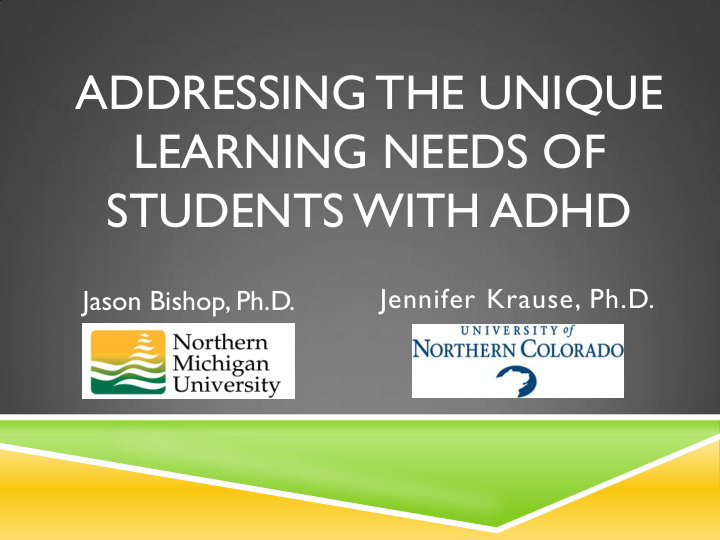



ADDRESSING THE UNIQUE LEARNING NEEDS OF STUDENTS WITH ADHD Jennifer Krause, Ph.D. Jason Bishop, Ph.D.
CHARACTERISTICS OF ADHD Most diagnosed neurobehavioral disorder of children (APA, 2000) 3-15% school age children (Visser et al, 2010) Display developmentally inappropriate behaviors Hyperactivity and impulsiveness Significant lack of attention Both
CHARACTERISTICS OF ADHD Symptoms affect children in multiple domains Academic (Lefever et al. 2002) Social (Bagwell et al, 2001) Behavioral (Barkley, 2006) Motor Domain (Harvey & Reid, 2003)
CHARACTERISTICS OF ADHD Motor domain issues 50% of children with ADHD also have developmental coordination disorder Experience delays and less accurate in processing and performing motor movements Experience locomotor and object control delays
WHAT IS IT LIKE TO HAVE ADHD? (WGBH Educational Foundation, 2002)
TREATMENT FOR ADHD “Clearly, the developing human brain and psyche were not designed to sit quietly in classrooms for hours on end.... Rather the brain was designed to frolic with other youngsters, especially out-of- doors” (Panksepp, 1996, p. 3) “A strong physical education program” - Recommended alternative to psychostimulants by the American Academy of Pediatrics (1987).
PERCEPTIONS OF COMPETENCE Perceptions of competence is a barrier to participating in PA (Healthy People, 2020) Children tend to report higher levels of competence than actual competence Positive Effects: Enhanced motivation and performance Increased task persistence Increased receptiveness to critical feedback
POSITIVE ILLUSORY BIAS (PIB) Children with ADHD tend to report “overly inflated” perceptions of competence = PIB Students with PIB fail to Recognize the need for improvement Acknowledge and accept critical feedback Change their approach in order to successfully complete a task (Milich & Okazaki, 1991) Children may report high levels of skill competency in order to “spare their self -confidence, protect their self-esteem, and ward of negative affect” (Owens & Hoza, 2003)
EFFECTS OF PIB Perceive practice as a waist of time because they perceive that they are already competent (defensive driving example) Dismiss instructional skill- related feedback Fail to change their approach to complete a novel task (Diener & Milich, 1997)
GUIDELINES TO ADDRESS PIB Give Positive Feedback At least one positive statement before giving critical feedback Feedback sandwich (P-C-P) Provide Direct Instruction and Feedback Bring it to the student’s attention that they are not performing at a high level
GUIDELINES TO ADDRESS PIB Remove the Instructor as the Source of Feedback Task cards Knowledge of Results before Knowledge of Performance
GUIDELINES TO ADDRESS PIB Design Activities that Provide Immediate Feedback Offer incentives Teacher’s Helper Gym time during lunch Choice in activities Technology can facilitate these strategies!
TECHNOLOGY CAN FACILITATE Highly effective approach for kids with ADHD (Bender & Bender, 1996) Advantages: High-speed, instant feedback Ability to self-control stimuli Bright colors and sounds Interactive aspects
TECHNOLOGY CAN HELP Video analysis applications on tablets Coach’s Eye Allows students to view their own movement and self-analyze Many kids with disabilities don’t obtain accurate proprioceptive feedback (they don’t accurately interpret messages on the relationship of their body parts to one another) Can compare to mature models
TECHNOLOGY CAN HELP Xbox Kinect Games Students can see themselves in the game as an avatar Able to have more self- control Need to perform correct movement in order to succeed in many games
PRACTICE Find a partner & select equipment/skill of your choice Peer- teach/coach your “partner with ADHD” the critical elements of the skill Implement at least one strategy below: Feedback Sandwich (positive-corrective-positive) Provide direct instruction Remove teacher as source of feedback Use video analysis (Coach’s Eye app) on iPad Use video/pictures on your own device Create a Task Card
SUMMARY Students with ADHD typically experience motor delays One cause of the delay is misperceptions of their skills Strategies are needed to address motor delay of these students Technology can help teach skills and decrease behavioral problems.
Recommend
More recommend